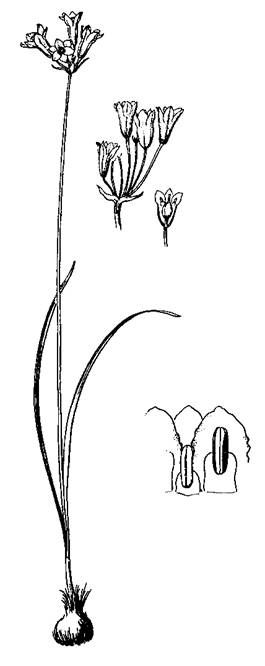Howell’s triteleia (Triteleia howellii) COSEWIC assessment and status report: chapter 3
Species Information
Name and classification
Triteleia howellii (S. Wats.) Greene
Brodiaea howellii S. Wats
Triteleia grandiflora Lindl. var howellii [S. Wats.] Hoover
Howell’s triteleia
Liliaceae: Lily family
Angiosperm
Description
Howell’s Triteleia, Triteleia howellii (S. Wats.) Greene, is a member of a genus of 14 species in North America (Keator 1993). Three species occur in British Columbia and Canada (Scoggan 1979; Pojar 2001).
Triteleia howellii is a perennial herb from a deep, straw-coloured, fibrous-scaly, nearly globe-shaped, bulb-like corm (Figure 1; Pojar 2001). The erect, flowering stem is 20-50 cm tall with one or two smooth, slender, linear basal leaves. The leaves are 20-40 cm long, 3-8 mm wide, sheathed at the base and have entire margins. The flowers consist of six whitish to blue, vase-shaped to narrowly bell-shaped, fused segments forming a 1.5-2 cm long tube. The corolla lobes, which are about as long as the tube, are in two, spreading, petal-like whorls, about as long as the tube. The outer three are broadly lanceolate, the inner three are oblong-egg-shaped and all are slightly ruffled. The fruit consists of a stalked, egg-shaped capsule containing black, rounded seeds.
Triteleia howellii has a similar appearance to its close relative T. grandiflora Lindl (large-flowered triteleia). It is distinguished from the latter by its flat filaments which are attached at the same level on the perianth tube (Pojar 2001). The filaments of T. grandiflora, in contrast, are not flat and are attached at two levels on the perianth tube.
Figure 1. Illustration of Triteleia howellii (Line drawing from Pojar 2001).
